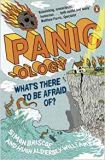Panicology by Simon Briscoe and Hugh Aldersey-Williams
| Panicology by Simon Briscoe and Hugh Aldersey-Williams | |
|
| |
| Category: Popular Science | |
| Reviewer: Magda Healey | |
| Summary: A successful attempt at putting some sense into the scare stories of recent years, each essay summarises essential facts and statistics while trying to ascertain the real risk and compare it to the level of panic. Best used as a reference tool when the readers start to wonder about a particular scare. | |
| Buy? Maybe | Borrow? Yes |
| Pages: 304 | Date: February 2008 |
| Publisher: Viking | |
| ISBN: 978-06709170 | |
|
| |
In Panicology, two British writers ( with a background in social and natural sciences) attempt to put some sense into the most popular scare stories that have appeared in the media in recent years. They analyse each of the subjects showing how the wide social factors (including the combined influence of media seeking sensation, political agendas of the government and opposition and changing social trends) contribute to the perception of risks and creation of panics - moral and otherwise.
Apart from reminding us of a lot of ways in which the human mind is not very good at dealing with statistical data, the authors also - at least half seriously - propose a replacement of a classic social science assessment of risk (a probability of event times its impact) by a "panic equation" in which a risk is estimated by multiplying hazard by outrage (and outrage, somehow, related to a media value of the danger). Thus, more stringent government warnings about travel to terrorist hotspots than locations at risk of volcanic eruption; and thus more people fearing fire than drowning even though many more drown than die in the fire.
Divided into sections dealing with social milieu, crime, science, environment, health and work life among others, each essay summarises essential facts and statistics while trying to ascertain the "real" risk and compare it to the level of panic. A neat pictorial summary completes each assessment, with a number of running headless chickens signifying panic, number of dice the actual risk, while number of risen fists the degree to which people can control their exposure.
One could argue about the choice of subjects: I would have certainly included AIDS in the health section and paedophiles in the crime one, as both are excellent examples of risks massively overstated by both media and government warnings, but one can't have everything.
A short and very useful summary of a sceptic tool kit plus death causes statistics for the UK complete the book.
I was impressed by the quality and quantity of data included by Briscoe and Aldersey-Williams. Some chapters are a veritable trove of statistics, with additional graphs and tables when needed, but all this data is used to support conclusions or enlighten and explain: it's not presented gratitiously and it's interpreted in an accessible and clear way.
There isn't really much of an attempt to analyse or try to establish the underlying systemic reasons for changing (and seemingly increasing) perceptions of risks. There are others, though, that attempt such diagnosis (see our suggested reading) and Panicology excels in working through a surprising number of issues in a honest, balanced and measured way.
In fact, I think that some subjects could have done with a little more scepticism, not only towards the media panics but also towards the official experts' view. It was particularly noticeable in essays relating to health scares, for example, obesity and salt consumption, where the blanket character of official advice was hardly questioned.
The most enjoyable, and the most informative, were, of course, the essays about the subjects in which the estimated gap between the public panic and actual risk was the greatest: the bird flu panic and the terrorism risk (5 headless chickens, 3 dice); the birth dearth and globalisation causing low pay & loss of jobs (2 chickens, 5 dice), MMR (5 chickens, 2 dice), cot death (3 chickens - obviously neither of the authors had babies recently, 1 dice), overfishing (1 chicken, 4 dice) and gender pay gap (3 chickens, 1 dice).
One think that Panicology could have done with was more frequent mention of a difference between association/correlation and causality. A lot of (pretty much all of, really) data relating to social phenomena is correlation data. Mathematical techniques exist that allow for possible speculation about the direction of relationship, but one of the most common ways that such results are interpreted is to imply causality where only an association exists. Implicitly, Panicology addresses the issue several times, but it is of such import that it could have been done even more.
Panicology reads well, but it's not really a book to read from cover to cover in one go - the amount of data is simply too much, and it would be best dipped into or read in sections, and probably best used as a reference tool when the readers start to wonder about a particular scare.
Thanks to the publishers for sending the BookBag this entertaining and informative gem!
For further reading we suggest The Tiger that Isn't by Blastland and Dilnot, Frank Furedi's Culture of Fear and Big Babies by Michael Bywater.
 Panicology by Simon Briscoe and Hugh Aldersey-Williams is in the Top Ten Books For The Defenders Of Reason.
Panicology by Simon Briscoe and Hugh Aldersey-Williams is in the Top Ten Books For The Defenders Of Reason.
Please share on: ![]() Facebook,
Facebook, ![]() Twitter and
Twitter and
![]() Instagram
Instagram
![]() You can read more book reviews or buy Panicology by Simon Briscoe and Hugh Aldersey-Williams at Amazon.co.uk Amazon currently charges £2.99 for standard delivery for orders under £20, over which delivery is free.
You can read more book reviews or buy Panicology by Simon Briscoe and Hugh Aldersey-Williams at Amazon.co.uk Amazon currently charges £2.99 for standard delivery for orders under £20, over which delivery is free.
![]() You can read more book reviews or buy Panicology by Simon Briscoe and Hugh Aldersey-Williams at Amazon.com.
You can read more book reviews or buy Panicology by Simon Briscoe and Hugh Aldersey-Williams at Amazon.com.
Comments
Like to comment on this review?
Just send us an email and we'll put the best up on the site.


